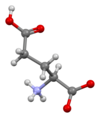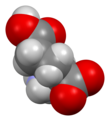Glutamic acid
 Skeletal formula of L-glutamic acid
| |||
| |||

| |||
| Names | |||
|---|---|---|---|
| IUPAC name
Glutamic acid
| |||
| Systematic IUPAC name
2-Aminopentanedioic acid | |||
Other names
| |||
| Identifiers | |||
3D model (
JSmol ) |
| ||
| 3DMet |
| ||
| 1723801 (L) 1723799 (rac) 1723800 (D) | |||
| ChEBI |
| ||
| ChEMBL |
| ||
| ChemSpider |
| ||
| DrugBank | |||
ECHA InfoCard
|
100.009.567 | ||
| EC Number |
| ||
| E number | E620 (flavour enhancer) | ||
| 3502 (L) 101971 (rac) 201189 (D) | |||
| KEGG | |||
PubChem CID
|
|||
| UNII |
| ||
CompTox Dashboard (EPA)
|
| ||
| |||
| |||
| Properties | |||
| C5H9NO4 | |||
| Molar mass | 147.130 g·mol−1 | ||
| Appearance | White crystalline powder | ||
| Density | 1.4601 (20 °C) | ||
| Melting point | 199 °C (390 °F; 472 K) decomposes | ||
| 8.57 g/L [1] | |||
| Solubility | Ethanol: 350 μg/100 g (25 °C)[2] | ||
| Acidity (pKa) | 2.10, 4.07, 9.47[3] | ||
| −78.5·10−6 cm3/mol | |||
| Hazards | |||
| GHS labelling: | |||

| |||
| Warning | |||
| H315, H319, H335 | |||
| P261, P264, P271, P280, P302+P352, P304+P340, P305+P351+P338, P312, P321, P332+P313, P337+P313, P362, P403+P233, P405, P501 | |||
| NFPA 704 (fire diamond) | |||
| Supplementary data page | |||
| Glutamic acid (data page) | |||
Except where otherwise noted, data are given for materials in their standard state (at 25 °C [77 °F], 100 kPa).
| |||
Glutamic acid (symbol Glu or E;
Its molecular formula is C
5H
9NO
4. Glutamic acid exists in two optically isomeric forms; the dextrorotatory L-form is usually obtained by hydrolysis of
The acid can lose one
2)−(CH
2)2−COO− prevails. The radical
The one-letter symbol E for glutamate was assigned in alphabatical sequence to D for aspartate, being larger by one methylene –CH2– group.[7]
Chemistry
Ionization

When glutamic acid is dissolved in water, the amino group (−NH
2) may gain a proton (H+
), and/or the carboxyl groups may lose protons, depending on the acidity of the medium.
In sufficiently acidic environments, both carboxyl groups are protonated and the molecule becomes a
At pH values between about 2.5 and 4.1,[8] the carboxylic acid closer to the amine generally loses a proton, and the acid becomes the neutral zwitterion −OOC−CH(NH+
3)−(CH
2)2−COOH. This is also the form of the compound in the crystalline solid state.[9][10] The change in protonation state is gradual; the two forms are in equal concentrations at pH 2.10.[11]
At even higher pH, the other carboxylic acid group loses its proton and the acid exists almost entirely as the glutamate
At even higher pH, the amino group loses the extra proton, and the prevalent species is the doubly-negative anion −OOC−CH(NH
2)−(CH
2)2−COO−. The change in protonation state occurs at pH 9.47.[11]
Optical isomerism
Glutamic acid is
History
Although they occur naturally in many foods, the flavor contributions made by glutamic acid and other amino acids were only scientifically identified early in the 20th century. The substance was discovered and identified in the year 1866 by the German chemist
Synthesis
Biosynthesis
Reactants
|
Products | Enzymes
| |
|---|---|---|---|
| Glutamine + H2O | → | Glu + NH3 | GLS2
|
NAcGlu + H2O |
→ | Glu + acetate | N-Acetyl-glutamate synthase |
NADP H + NH4+ |
→ | Glu + NADP + + H2O
|
GLUD2[17]
|
α-Ketoglutarate + α-amino acid |
→ | Glu + α-keto acid | Transaminase |
1-Pyrroline-5-carboxylate + NAD+ + H2O |
→ | Glu + NADH | ALDH4A1
|
FH4 |
→ | Glu + 5-formimino-FH4
|
FTCD
|
| NAAG | → | Glu + NAA | GCPII |
Industrial synthesis
Glutamic acid is produced on the largest scale of any amino acid, with an estimated annual production of about 1.5 million tons in 2006.[18] Chemical synthesis was supplanted by the aerobic fermentation of sugars and ammonia in the 1950s, with the organism Corynebacterium glutamicum (also known as Brevibacterium flavum) being the most widely used for production.[19] Isolation and purification can be achieved by concentration and crystallization; it is also widely available as its hydrochloride salt.[20]
Function and uses
Metabolism
Glutamate is a key compound in cellular
- R1-amino acid + R2-α-ketoacid ⇌ R1-α-ketoacid + R2-amino acid
A very common α-keto acid is α-
- pyruvate+ glutamate
- oxaloacetate+ glutamate
Both
Glutamate also plays an important role in the body's disposal of excess or waste nitrogen. Glutamate undergoes deamination, an oxidative reaction catalysed by glutamate dehydrogenase,[17] as follows:
Ammonia (as ammonium) is then excreted predominantly as urea, synthesised in the liver. Transamination can thus be linked to deamination, effectively allowing nitrogen from the amine groups of amino acids to be removed, via glutamate as an intermediate, and finally excreted from the body in the form of urea.
Glutamate is also a neurotransmitter (see below), which makes it one of the most abundant molecules in the brain. Malignant brain tumors known as glioma or glioblastoma exploit this phenomenon by using glutamate as an energy source, especially when these tumors become more dependent on glutamate due to mutations in the gene IDH1.[21][22]
Neurotransmitter
Glutamate is the most abundant excitatory
Brain nonsynaptic glutamatergic signaling circuits
Extracellular glutamate in
GABA precursor
Glutamate also serves as the precursor for the synthesis of the inhibitory
Flavor enhancer
Glutamic acid, being a constituent of protein, is present in foods that contain protein, but it can only be tasted when it is present in an unbound form. Significant amounts of free glutamic acid are present in a wide variety of foods, including
Nutrient
All meats, poultry, fish, eggs, dairy products, and kombu are excellent sources of glutamic acid. Some protein-rich plant foods also serve as sources. 30% to 35% of gluten (much of the protein in wheat) is glutamic acid. Ninety-five percent of the dietary glutamate is metabolized by intestinal cells in a first pass.[32]
Plant growth
Auxigro is a plant growth preparation that contains 30% glutamic acid.
NMR spectroscopy
In recent years,[when?] there has been much research into the use of residual dipolar coupling (RDC) in nuclear magnetic resonance spectroscopy (NMR). A glutamic acid derivative, poly-γ-benzyl-L-glutamate (PBLG), is often used as an alignment medium to control the scale of the dipolar interactions observed.[33]
Role of glutamate in aging
Pharmacology
The drug
Glutamate toxicity can be reduced by antioxidants, and the psychoactive principle of cannabis, tetrahydrocannabinol (THC), and the non psychoactive principle cannabidiol (CBD), and other cannabinoids, is found to block glutamate neurotoxicity with a similar potency, and thereby potent antioxidants.[38][39]
See also
References
- ^ "L-Glutamic acid". National Library of Medicine. Retrieved 24 June 2023.
- ISBN 978-3540699330.
- ^ "Amino Acid Structures". cem.msu.edu. Archived from the original on 11 February 1998.
- ^ "Nomenclature and Symbolism for Amino Acids and Peptides". IUPAC-IUB Joint Commission on Biochemical Nomenclature. 1983. Archived from the original on 29 August 2017. Retrieved 5 March 2018.
- ^ Webster's Third New International Dictionary of the English Language Unabridged, Third Edition, 1971.
- ^ Robert Sapolsky (2005), Biology and Human Behavior: The Neurological Origins of Individuality (2nd edition); The Teaching Company. pp. 19–20 of the Guide Book.
- .
- ^ PMC 1263308.
- .
- S2CID 93590487.
- ^ ISBN 0495388572, 978-0495388579.
- ^ National Center for Biotechnology Information, "D-glutamate". PubChem Compound Database, CID=23327. Accessed 2017-02-17.
- PMID 9501533.
- ^ R. H. A. Plimmer (1912) [1908]. R. H. A. Plimmer; F. G. Hopkins (eds.). The Chemical Constitution of the Protein. Monographs on biochemistry. Vol. Part I. Analysis (2nd ed.). London: Longmans, Green and Co. p. 114. Retrieved 3 June 2012.
- ^ Renton, Alex (10 July 2005). "If MSG is so bad for you, why doesn't everyone in Asia have a headache?". The Guardian. Retrieved 21 November 2008.
- ^ "Kikunae Ikeda Sodium Glutamate". Japan Patent Office. 7 October 2002. Archived from the original on 28 October 2007. Retrieved 21 November 2008.
- ^ .
- ISBN 978-0-470-12407-9.
- ISBN 978-0-471-79930-6.
- PMID 22006024.
- PMID 24747768.
- PMID 25074540.
- ^ PMID 10736372.
- S2CID 37400348.
- PMID 20308566.
- ^ PMID 17202478.
- PMID 11752112.
- PMID 16787421.
- PMID 7494864.
- ^ Krueger, Christian; Stöker, Winfried; Schlosser, Michael (2007). "GLUTAMIC ACID DECARBOXYLASE AUTOANTIBODIES". Autoantibodies (2nd ed.). pp. 369–378.
- PMID 35717735.
- PMID 10736365.
- ^ C. M. Thiele, Concepts Magn. Reson. A, 2007, 30A, 65–80
- S2CID 6029856.
- S2CID 3357749.
- PMID 10736373.
- PMID 19571220.
This organization does not allow net glutamate entry to the brain; rather, it promotes the removal of glutamate and the maintenance of low glutamate concentrations in the ECF.
- PMID 9653176.
- S2CID 39496546.
Further reading
- Nelson, David L.; Cox, Michael M. (2005). Principles of Biochemistry (4th ed.). New York: W. H. Freeman. ISBN 0-7167-4339-6.




